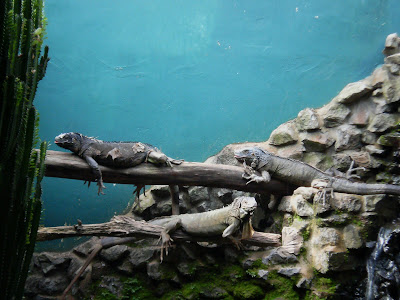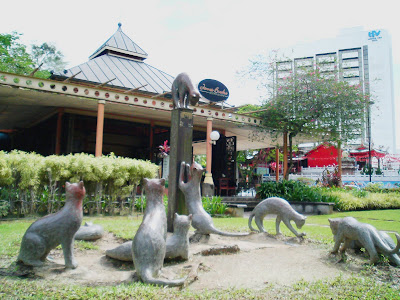 At a roadside stall in Kampung Buntal these 'nenas' ( Malay word for pineapple) caught my attention. Three of those were sold at RM 2 and you can mix you choice. The top variety is called Nenas Johore and below it is Nenas Sarawak. Both of which I would like to describe as 'manis', another Malay word for sweet.
At a roadside stall in Kampung Buntal these 'nenas' ( Malay word for pineapple) caught my attention. Three of those were sold at RM 2 and you can mix you choice. The top variety is called Nenas Johore and below it is Nenas Sarawak. Both of which I would like to describe as 'manis', another Malay word for sweet.Wednesday, February 25, 2009
Call me ' Nenas Manis'
 At a roadside stall in Kampung Buntal these 'nenas' ( Malay word for pineapple) caught my attention. Three of those were sold at RM 2 and you can mix you choice. The top variety is called Nenas Johore and below it is Nenas Sarawak. Both of which I would like to describe as 'manis', another Malay word for sweet.
At a roadside stall in Kampung Buntal these 'nenas' ( Malay word for pineapple) caught my attention. Three of those were sold at RM 2 and you can mix you choice. The top variety is called Nenas Johore and below it is Nenas Sarawak. Both of which I would like to describe as 'manis', another Malay word for sweet.
Labels:
Agriculture,
Fruits of Kuching,
Kampung Buntal
Monday, February 23, 2009
Hanging handkerchiefs

These white to light purple young leaves hang like long handkerchiefs from the the tip of the yellow saraca ( Saraca thaipingensis ) tree branches. I saw two stretches of roads at the BDC housing estate this morning which have these mature trees in their initial blooming stage.
In India a close relative of this tree is the Ashoka tree ( Saraca asoca ) underwhich it was believed Buddha was born and as such the tree is considered sacred among adherents of the Buddhist faith.
The variety we have here has bright yellow flowers which are fragrant, especially at night. This is an evergreen tree and is considered small as they very rarely reach more than 20 m. Over the years I have observed one specimen at the Sarawak Museum gardens and to my knowledge have been there for more than 15 years now and still retain a height of not more than 6m. I think this tree is a rarity even though it is native to this part of the world. As such I think it is good if other places in Sarawak emulate the planting of this species mainly for its unique look and blooms.
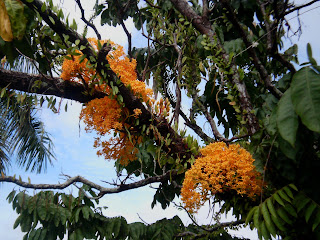 Close up of the bright yellow blooms of the saraca.
Close up of the bright yellow blooms of the saraca.The flowers are attactive to bees and birds.
A characteristic of the saraca is its peculiar habit of having blooms emerging on the sides of older branches as seen here.
Sunday, February 22, 2009
Red Japanese Bridge
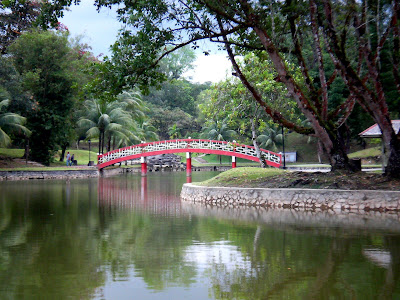 The Kuching Reservoir Park is a popular jogging, walking, exercise and picnic venue for many Kuching residents and visitors. Its lush greenery and many ponds provides much tropicalness to the area. I find the red Japanese bridge a pretty focal point and provides a strong element of interest to the park. The reservoir was built more than 100 years ago to store and filter water for the consumption of Kuching's town population then. Now it functions wholly as a public park.
The Kuching Reservoir Park is a popular jogging, walking, exercise and picnic venue for many Kuching residents and visitors. Its lush greenery and many ponds provides much tropicalness to the area. I find the red Japanese bridge a pretty focal point and provides a strong element of interest to the park. The reservoir was built more than 100 years ago to store and filter water for the consumption of Kuching's town population then. Now it functions wholly as a public park.Spinning Tops
 Yesterday I came across a show and performance of spinning tops at the Kuching Waterfront's amphitheatre area. Most of the spinning tops were from the various ethnic groups of Malaysia. At the centre of the picture is one that is still spinning on a chair. A Kelantanese spinning top called a 'gasing' can spin for as long as two and a half hours.
Yesterday I came across a show and performance of spinning tops at the Kuching Waterfront's amphitheatre area. Most of the spinning tops were from the various ethnic groups of Malaysia. At the centre of the picture is one that is still spinning on a chair. A Kelantanese spinning top called a 'gasing' can spin for as long as two and a half hours.Saturday, February 21, 2009
A Star is Born
Thursday, February 19, 2009
India Street
 The Indian Muslim community does brisk business at India Street where they specialise in imported textiles, books and magazines especially Islamic religious books, currency exchange, restaurants and spices. Walking past their crowded shop that overflowed into the five-foot way I could smell the rich aroma of perfumes and freshly cooked curries. A must visit when in Kuching. The presence of a large variety of businesses carried out by the Indians here have made the venue popularly known as 'Little India'.
The Indian Muslim community does brisk business at India Street where they specialise in imported textiles, books and magazines especially Islamic religious books, currency exchange, restaurants and spices. Walking past their crowded shop that overflowed into the five-foot way I could smell the rich aroma of perfumes and freshly cooked curries. A must visit when in Kuching. The presence of a large variety of businesses carried out by the Indians here have made the venue popularly known as 'Little India'.
Labels:
Currency exchange,
India Street,
Indian community,
Shopping
Hawkers Food Centre at Satok
 Not to be misssed in Kuching is the nightly hawkers food centre at Satok. It's my favourite haunt for satay, mee, soup, burgers and barbecued chicken and the popular ' ikan terubok'.
Not to be misssed in Kuching is the nightly hawkers food centre at Satok. It's my favourite haunt for satay, mee, soup, burgers and barbecued chicken and the popular ' ikan terubok'.In the day time the site is a car parking lot but come 6.00 pm it metamorphosed into a food centre ala hawkers style. Business hours end in the wee hours of the morning.
 At this stall one can get a variety of barbecued items like finely sliced and spicely marionetted chicken meat the locals call 'satay' hence the stall is normally referred to as a 'satay' stall and the operator/owner the 'satay man'. Traditionally the 'satay man' uses an organic fan made from local palm leaves to blow the burning charcoal. However increasingly many opt for the electric fan which does the job just as well minus the romanticism.
At this stall one can get a variety of barbecued items like finely sliced and spicely marionetted chicken meat the locals call 'satay' hence the stall is normally referred to as a 'satay' stall and the operator/owner the 'satay man'. Traditionally the 'satay man' uses an organic fan made from local palm leaves to blow the burning charcoal. However increasingly many opt for the electric fan which does the job just as well minus the romanticism.
Labels:
Hawkers food,
Night shopping,
Shopping at Satok
Tuesday, February 17, 2009
Historical pillars of Kuching
Entrance to the Sarawak Tourism Complex
Kuching has more than its share of historical buildings in Sarawak. In fact I think more than. Compared to Bintulu for instance where there is none. Therefore a walk around downtown Kuching city is a journey into the past when the Brookes and then the later British colonialists constructed buildings in the tradition we name today as the 'colonial style'. The above entrance arch serves as balcony to what was before the Court House. As I walked in through the balcony I was impressed by the tall round columns that hold the ceiling of the verandah past the balcony space as seen in the picture below.
 These columns look imposing and full of grandeur much inspired by the massive columns of Roman court house architecture. After the first Council Negeri meeting was held at Bintulu in 1876, all subsequent meetings from 1878 till1973 were held at this Court House. However very recently its was converted into Sarawak Tourism Complex building.
These columns look imposing and full of grandeur much inspired by the massive columns of Roman court house architecture. After the first Council Negeri meeting was held at Bintulu in 1876, all subsequent meetings from 1878 till1973 were held at this Court House. However very recently its was converted into Sarawak Tourism Complex building.Iguana shedding skin
Most colourful building
Friday, February 13, 2009
Cordyline Inflorescence
River boat ferry
 You need to board this small river boat ferry, locally called 'perahu tambang' to cross the Sarawak River that meanders by the Kuching City centre area. Fare is RM0.50 per crossing. The still waters of the Sarawak river makes the crossing a breeze. The boat is powered by a small inboard engine.
You need to board this small river boat ferry, locally called 'perahu tambang' to cross the Sarawak River that meanders by the Kuching City centre area. Fare is RM0.50 per crossing. The still waters of the Sarawak river makes the crossing a breeze. The boat is powered by a small inboard engine. Shophouse in Off Beat Colours
It's interesting to see these days how shopowners in the city are willing to makeover their shop. The use of off beat colours add much lustre and live to the street. The square columns are made of bricks when at the time of their construction today's reinforced conrete technology were unheard of. I find the detailing on the pillars characteristic of the time just as the typical one floor building structure, of which the first floor was used as living accomodation for the shopkeeper's family. This is the traditional way of 'working from home', I guess.
Labels:
Architecture,
Kuching Historical Buildings,
Shopping
Thursday, February 12, 2009
Visit to a Crocodile Farm
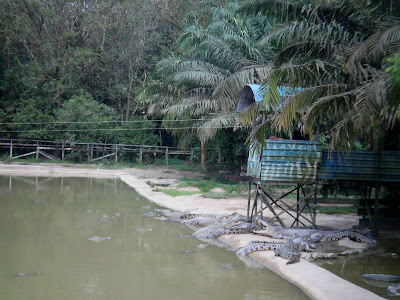 The Jong crocodile farm is about 25 km from Kuching City centre. It is easily reached by taxi . Here two types of crocodiles are bred in captivity, viz the saltwater or estuarine crocodile ( Crocodylus porpous) and the freshwater or inland crocodile ( Tomistoma schlegii ). The farm is a private undertaking by the Jong family. Above is one of the two ponds where feeding time is watched by visitors and tourists who pay RM 10 (adults) per entry. But I thought the charges were well worth it when you see their big collection of crocodiles and other animals in the mini zoo within the generous 25 acres site. I paid a visit to the farm on 10/2/09 at 3.00 pm to watch them feed these ferocious carnivorous reptiles, an ancient relic of the dinosaur family.
The Jong crocodile farm is about 25 km from Kuching City centre. It is easily reached by taxi . Here two types of crocodiles are bred in captivity, viz the saltwater or estuarine crocodile ( Crocodylus porpous) and the freshwater or inland crocodile ( Tomistoma schlegii ). The farm is a private undertaking by the Jong family. Above is one of the two ponds where feeding time is watched by visitors and tourists who pay RM 10 (adults) per entry. But I thought the charges were well worth it when you see their big collection of crocodiles and other animals in the mini zoo within the generous 25 acres site. I paid a visit to the farm on 10/2/09 at 3.00 pm to watch them feed these ferocious carnivorous reptiles, an ancient relic of the dinosaur family.As part of the main show a whole chicken piece is lowered to the middle of the pond and the more adventurous of the crocs fight for the special prize of the day.
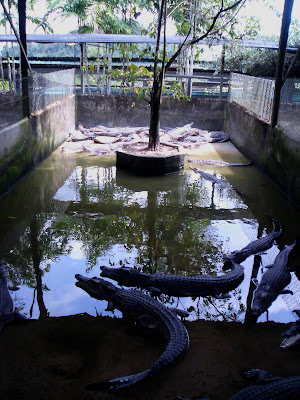 Juvenile crocodiles are kept in separate enclosures .
Juvenile crocodiles are kept in separate enclosures .
The farm is able to breed crocodiles after many years of trial and error. To date there are about 500 of them born at the farm.
 Juvenile crocodiles are kept in separate enclosures .
Juvenile crocodiles are kept in separate enclosures .The farm is able to breed crocodiles after many years of trial and error. To date there are about 500 of them born at the farm.
Wednesday, February 11, 2009
Hibiscus Cultivars at the Museum Garden
At the Sarawak Museum garden yesterday I saw these colourful blooms of the hibiscus. The red type hibiscus ( Hibiscus rosa-sinensis) is the national flower of Malaysia and is lovingly called ' Bunga Raya'. Many people believe that the hibiscus originated from east Aftrica. However there are claims that it has its origins in China and the Paciific Islands. Nowadays there are hundreds of cultivars and they can appear in various colours like below.
Monday, February 9, 2009
Corner Landscape Detailing

Successive layering is achieved through proper use of plants and colours
Saturday, February 7, 2009
Orang Ulu Beadswork

Pencil holder placed on a beaded table mat.
 The motifs vary from mythical animals, birds, dragons and patterns from plant life like flowers, fern fronds and shapes of leaves. The patterns and motifs are typical Borneoan in origin and so is the choice of colours. The above rectangular table mats come in various sizes. Square ones ( 30x30cm) and large rectangular pieces ( 60x150cm).
The motifs vary from mythical animals, birds, dragons and patterns from plant life like flowers, fern fronds and shapes of leaves. The patterns and motifs are typical Borneoan in origin and so is the choice of colours. The above rectangular table mats come in various sizes. Square ones ( 30x30cm) and large rectangular pieces ( 60x150cm).Friday, February 6, 2009
Clothings at 50-70% Discount
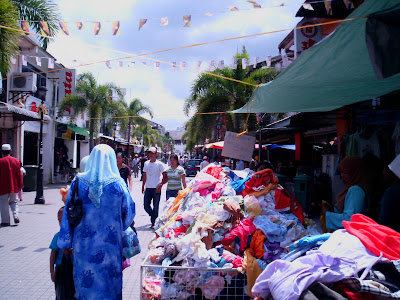 I came upon this bundle of clothings that are sold at 50-70%discount by the India Street sidewalk. The reason the shopkeepers here disposed them cheaply was due to the heavy rains and high tide that brought in the river waters creeping into the shophouses thus drenching the clothings . The clothings that got drenched were disposed by selling them at fantastic discounts. Last month Kuching received its highest rainfall in two days, equivalent to about 400 mm of rain. The amount of rain that Kuching normally received in a year ( over many years now) is only 300 mm. Well you can imagine how wet was Kuching when the equivalent of a year's rain was soaked into two days.
I came upon this bundle of clothings that are sold at 50-70%discount by the India Street sidewalk. The reason the shopkeepers here disposed them cheaply was due to the heavy rains and high tide that brought in the river waters creeping into the shophouses thus drenching the clothings . The clothings that got drenched were disposed by selling them at fantastic discounts. Last month Kuching received its highest rainfall in two days, equivalent to about 400 mm of rain. The amount of rain that Kuching normally received in a year ( over many years now) is only 300 mm. Well you can imagine how wet was Kuching when the equivalent of a year's rain was soaked into two days.Street of Spices
 Shopping for spices is made easy in Kuching. At Gambier Street are found many spices shops that are operated by Indian Muslims. Here spices from all over the world are sold in small outlets that encroached onto 5-footways and sidewalks. The place is bustling everyday and must have been like this in the early 19th century when 'gambier' a shrub widely cultivated in Sarawak was traded here for its extract used in dyeing and tanning of leather,hence its name 'Gambier Street'.
Shopping for spices is made easy in Kuching. At Gambier Street are found many spices shops that are operated by Indian Muslims. Here spices from all over the world are sold in small outlets that encroached onto 5-footways and sidewalks. The place is bustling everyday and must have been like this in the early 19th century when 'gambier' a shrub widely cultivated in Sarawak was traded here for its extract used in dyeing and tanning of leather,hence its name 'Gambier Street'. Close up of a shop fully stocked with spices and related ingredients for making spicy dishes like curry.
Close up of a shop fully stocked with spices and related ingredients for making spicy dishes like curry.Wednesday, February 4, 2009
Kuching in bronze
 At the Kuching waterfront is seen this bronze sculpture of a group of local cats. The city's named has been accredited to cats. One theory suggests that it derived its name from the spot where there were plenty of trees the locals here called 'mata kuching' that have seeds like cat's eyes. This spot close to where the city now is was a natural gathering place of ships and boats that came in to town to trade. Overtime the town was described by the river spot where the trading ships or boats berthed albeit by the shade of the 'mata kuching' trees. Another theory suggests that the prevalence of cats around the town had made people adopt the name 'Kuching' ( malay word for cat) to better describe the locality. Whatever theory you are inclined to follow it all boiled down to cats, cats,cats. Kuching is for cats.
At the Kuching waterfront is seen this bronze sculpture of a group of local cats. The city's named has been accredited to cats. One theory suggests that it derived its name from the spot where there were plenty of trees the locals here called 'mata kuching' that have seeds like cat's eyes. This spot close to where the city now is was a natural gathering place of ships and boats that came in to town to trade. Overtime the town was described by the river spot where the trading ships or boats berthed albeit by the shade of the 'mata kuching' trees. Another theory suggests that the prevalence of cats around the town had made people adopt the name 'Kuching' ( malay word for cat) to better describe the locality. Whatever theory you are inclined to follow it all boiled down to cats, cats,cats. Kuching is for cats.Idyllic Kuching
At the Kuching waterfront yesterday I noticed the idyllic Astana which is home to the Governor of Sarawak. In Malay the proper term to call the Governor is ' Tuan Yang Di Pertua Negeri '.
The still waters of the Sarawak River that meanders by it makes an excellent post card view.
 These deep sea fishing trawlers are having a rest. Wait. You mean just opposite the residency?
These deep sea fishing trawlers are having a rest. Wait. You mean just opposite the residency?Yes, they are berthed for many weeks here due to the dangerously high seas and the north easterly winds that have no mercy on small fishing vessels when they bash the coastal regions of Sarawak during the rainy monsoon season ( November to February) yearly.
Subscribe to:
Posts (Atom)




